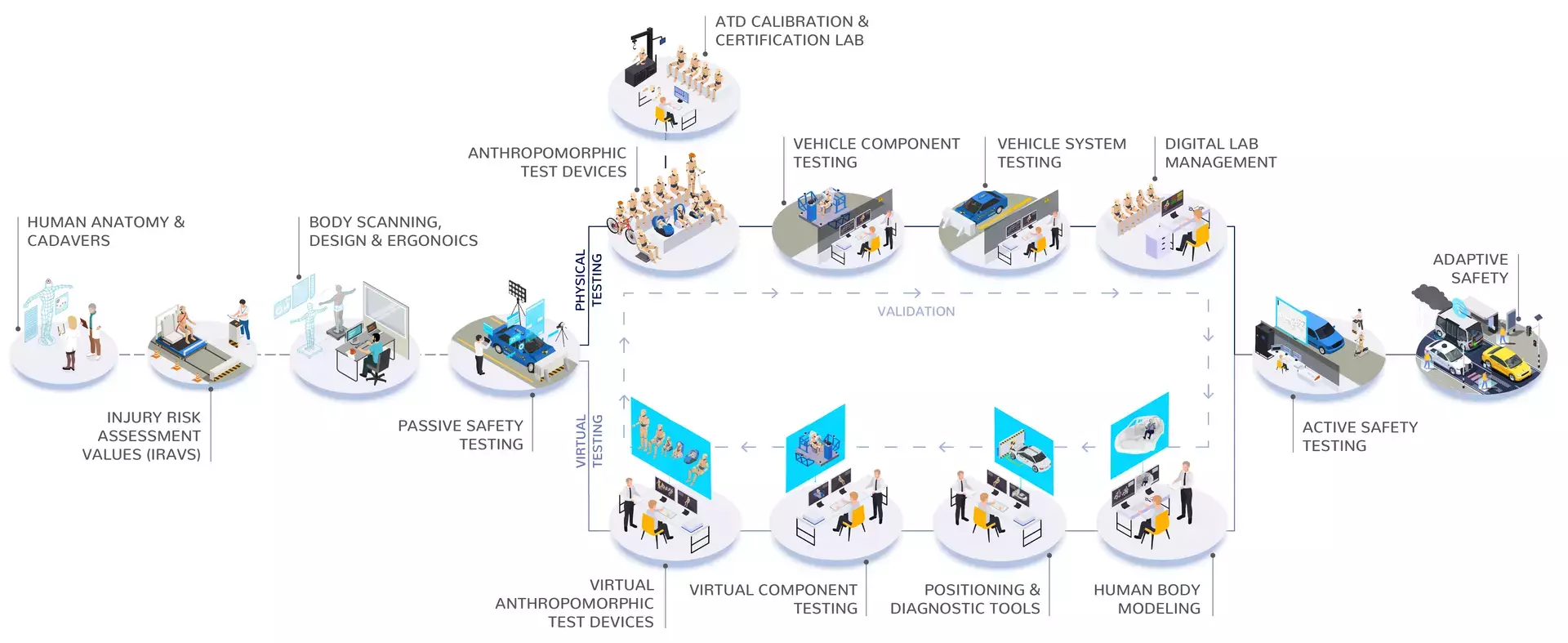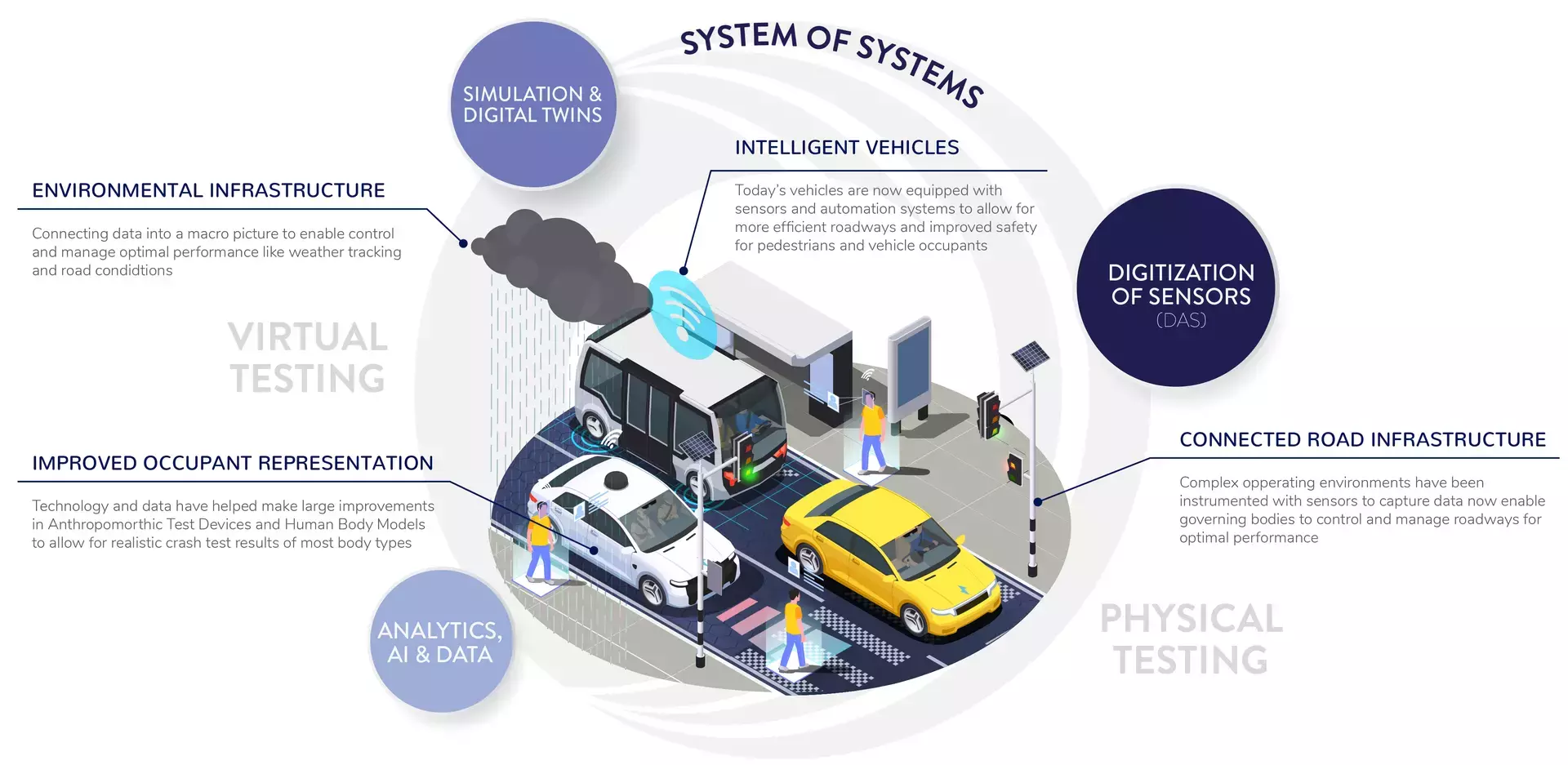In the time it takes you to read this article, one more family will be mourning the loss of a loved one - dealing with the monumental, unfathomable, future ahead of them.
Another 15 families will be coming to grips with the reality of supporting someone with a severe, life-changing injury. Over 40,000 people lose their lives in the US every year in automobile-related crashes, and a further 1,000,000 suffer severe injury. While Europe has largely succeeded in driving road deaths downward, the US has failed to buck the trend.
Safety As A Mission
A large proportion of these lives could be saved if we treated Safety as a Mission. Humanetics does – as do many other companies, manufacturers and vehicle designers. Every day we wake up and ask ourselves: what more can we do to protect humans in motion?

Since its inception in Sweden in the 1990s, Vision Zero has expanded across Europe and is gaining momentum in major American cities. Central to this commitment is the Safe Systems approach which addresses the entire traffic system —human behavior, vehicle design, road infrastructure, and emergency response. This approach emphasizes safety as a shared responsibility and integrates multiple layers of protection to accommodate human errors and prevent severe outcomes. The rapid pace of technological advancements presents exciting possibilities for saving lives. Regulators and engineers are working together to harness this potential, accelerating the adoption of new technologies. OEMs are rising to the challenge of balancing faster production with enhanced safety and cost efficiency.

...BUT, are we collectively doing enough? Are we moving fast enough to meet any of the goals of Vision Zero? It's becoming increasingly clear that we cannot effectively reduce traffic fatalities and injuries without implementing additional regulations and safety measures.
In this multi-part series, we will explore our understanding of Safety as a Mission.
What we Mean by Safety as A Mission
In the first part of this series, we will explain what we mean by Safety as a Mission. We will review what we have achieved so far and consider the challenges ahead of us.
We will explore exciting technology developments offering new ways to improve safety, as well as some of the challenges and changes we face in implementing them to achieve better outcomes, while not increasing costs burdens across the industry and on consumers.
Accelerating Innovation
In the second part, we will examine specific areas of innovation we can accelerate if we align behind the biggest issues to develop a shared vision to improve processes, efficiency and investments. We will look at how to improve equitable representation in vehicle comfort and safety through the use of improved digital human representations and human body models.
We will investigate the challenges and opportunities in generating and managing data across the physical crash test process and how to correlate and configure those results with data from simulation and data models. Lastly, we will look at how software in the crash test lab and on the proving ground can help drive efficiency and simplify the test process, enabling car makers to bring better products to market faster, with significantly reduced development costs.
An Autonomous Future
In the final part, we look further ahead to a world where human-controlled and fully autonomous vehicles share roadways. We will ask questions about the skills and systems we need to develop to ensure power, management and control is ultimately in human hands in this promised autonomous world.
Our Evolving Perspective
Our perspective has evolved over time. It is clear to us that we need to look at the end-to-end process required to bring a new vehicle to market from design to production. An integrated ecosystem offers numerous advantages beyond just our products, benefiting users across various sectors by creating a cohesive environment that enhances efficiency, performance and user convenience.

Products are designed to work together to eliminate compatibility issues, reducing setup time and simplifying maintenance. When products operate as part of a unified system, they communicate and share data more effectively, leading to optimized performance and greater overall capabilities. Simplified workflows and centralized management make operations more straightforward, enhancing the user experience and maximizing resource utilization.
Critical Factors of Industry Success
The critical factors for our success hinge on several key strategies: integrating new life-saving technologies into our tool portfolio, reducing development costs to allow for reinvestment in innovative technologies, and unifying data across siloed systems related to vehicles, roads, occupants and the environment.

One example, is more use of adaptable restraint systems that recognize and accommodate the diverse physical characteristics of passengers. By acknowledging that individuals vary greatly in terms of size, age, body composition, and physical abilities, manufacturers are developing innovative restraints that can adjust in real-time to provide optimal protection for each occupant, regardless of their unique physical attributes. These types of innovations can go a long way is protecting and accommodating every vehicle occupant.
Additionally, we aim to combine physical and virtual testing to enhance biofidelity and address fragmentation, expand the representation of occupants in safety design, and accelerate technologies that safeguard pedestrians, cyclists and road users.
UP NEXT: Does a change in outcomes demand a change in policy and regulation?
Our 'Safety as a Mission' article series covers several key topics in advancing safety technology to save lives. Click the articles below to continue reading about 'Safety as a Mission:
- Part 1: Embracing the Integrated Ecosystem
- Part 2: Our Shared Mission is to Prevent Millions from Dying
- Part 3: A Vision Inspires Hope. A Mission Demands Action
- Part 4: Equitable Design: Design for Every Body
- Part 5: Pedestrians Take a Hit
- Part 6: Next Generation ATDs & the Connected Lab
- Part 7: Welcome to the Proving Grounds: Smart Testing for Crash Prevention
- Part 8: Partnership as an Accelerator: The Agile Model of Development
- Part 9: Conclusion: Safety as a Mission: The Need for Action.
Want to Read More?
Subscribe to the Humanetics Pulse newsletter to learn more about safety as a mission and the full ecosystem.

Barney Loehnis
Barney is the President of Humanetics Sensors & Chief Marketing Officer, leading our Sensor group and marketing growth programs, strategic communications, and customer experience design. He has led marketing and digital transformations in Europe, Asia and the USA in B2B, B2C and agency sectors, for clients like IBM, VW, Huawei, Qualcomm and Mercer Consulting. Barney is a British and American citizen, a bad runner and avid cook.


